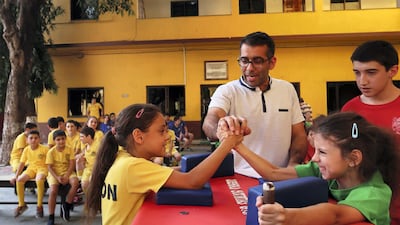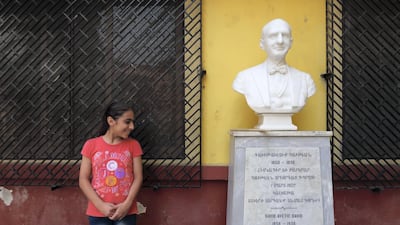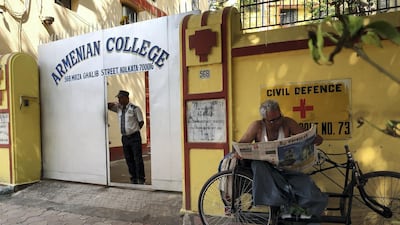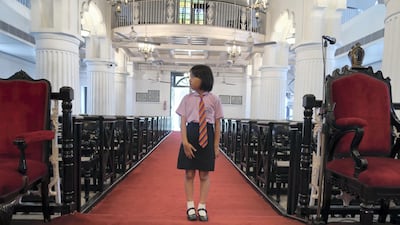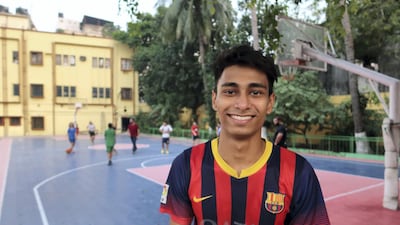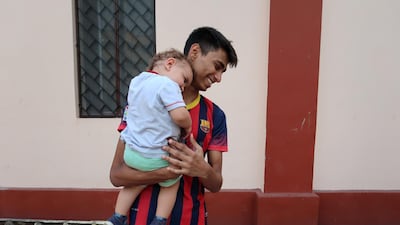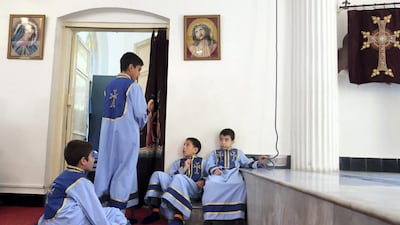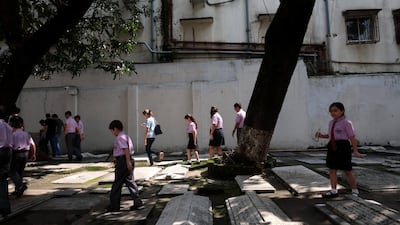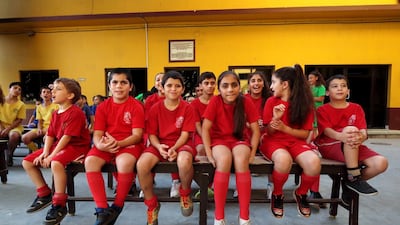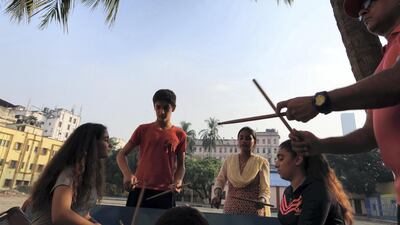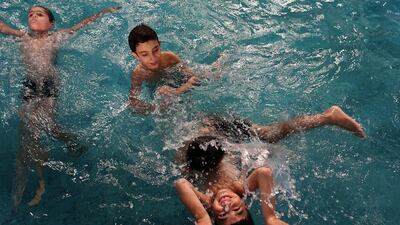For someone who has not seen the outside of the gates, it would be impossible to guess the location of the schoolyard. Yellow buildings line it on either side, and trees provide shade in the corners. Under the big green canopy of one is a table set up for arm wrestling. All students are there, dressed in red, blue, green or yellow – the colours of the school's four houses.
“There’s always fierce competition between the houses. Levon is always on top in football, but I don’t know how we will do today,” says Vladimir Grigoryan, a student dressed in the yellow of the ancient Armenian king.
The other houses are also dedicated to Armenian regents: Haik, Trdent and Tigran, mighty figures in the history of the small Caucasus nation. The names of the students, as they get called up one by one, are equally Armenian-sounding – as are their cheers, when the matches get under way.
Everything about the Armenian College and Philanthropic Academy seems typically Armenian – except that is located in Kolkata, the largest city in eastern India.
“It’s a school unlike any other. It is Armenia, but outside of Armenia,” says Razmik Hakobian, another student at the academy. He looks up from the table where he is placing medals in gold, silver and bronze in long, neat rows. He came to the school in 2005, from a small, but long-established Armenian community in Baghdad. It had never been a plan to send him to India, but as the situation grew worse in Iraq, his family saw no better option. “It was very bad at the time, with bombs and fighting everywhere. My parents got to know about the school from an Armenian who came to Baghdad, and decided to send me,” he says.
Children arriving alone, from a country far away, is typical at the Armenian College and Philanthropic Academy. It welcomes Armenian children from all over the world, and offers entirely free education and boarding. Most students come from Armenia, but there are also children from Iran and Iraq, three sisters from Russia and, as of August this year, a girl from Myanmar.
“She is only seven and doesn’t speak Armenian yet, her family only speaks Burmese. But she is learning,” says Movses Sargsyan, one of two priests employed by the college. He sits in a chair inside his office, on the first floor overlooking the yard outside. There are stacks of paper on his desk, and a plate with black sesame sweets, brought back from Yangon where he goes twice a month, to serve the tiny Myanmarese-Armenian community. “They are only 20 people now, but there is a church. And we have to maintain it,” he says.
The Armenian diaspora in Asia
Myanmar is far from the only place with an Armenian population. Of a total population of 11 million, there are some seven million Armenians living abroad, meaning the Armenian diaspora is one of the largest in the world. Asia housed a number of Armenian communities throughout history, as a result of wide-stretching trading networks. Some are gone today, such as those of Kabul and Dhaka. Others are marginal in size. But it was Kolkata, then the capital of the British Empire in India, that had the region's most prosperous and sizeable community, with numbers once in the several thousands. The very first Armenians had arrived in India in the 1600s, after an invitation from the Mogul emperor Akbar to "come and settle in his dominions." They reached Bengal in 1645, before any of the European colonisers.
The marks they left can still be seen all over the city: grandiose buildings and hotels (Armenians were the first hoteliers of Kolkata), several well-maintained churches (where the students go for mass each Sunday) and a port still known as the “Armenian ghat”. But their numbers are dwindling. Kolkata’s Armenian population is fewer than 200 today, and that includes the students. Of them, only four are Indian-Armenian. “I never even knew that I was Armenian until my dad told me to join this school. I remember people telling me so when I was a child, but I never knew what they meant,” says Zaven Gasper, a student whose father is Armenian and mother is Indian.
A little boy, just turned two, keeps grabbing hold of and playing with his legs. He is Vartan, the son of a former student who is trying to establish his family in Kolkata. But few students stay to bring up families here. Most choose to return home after graduation. “I will go back to Armenia. Sometimes I ask myself what I am doing here, so far from my own country. But then I tell myself that it is best to finish my education,” says Rima Sargsyan, who received a scholarship after graduation to continue studying at one of Kolkata’s best institutions.
The legend of Sir Catchick Paul Chater
The door is open into the main building, where the walls are full with framed photographs chronicling the life and history of the school. There are photos of rugby athletes – the college is famed for its team, which has produced several players for India’s national team – and individuals who have donated to the college. No portrait looms larger than that of Sir Catchick Paul Chater, a businessman of Armenian descent born in Kolkata. He is the main reason why the school can offer education for free. “Chater was a legendary man. He lost his parents as a child, then went to Hong Kong where he became a millionaire. All ports in Hong Kong were built by him. And he donated big sums of money to the school, to be used for the students,” says Armen Makarian, Armenian College and Philanthropic Academy’s co-ordinator.
Makarian was born in Iran, where there still is a sizeable Armenian community. In fact, India’s connection with Armenia is also a link with Iran: it was from there that the first Armenians came. “Almost all Armenians in India originate from Iran. The school is maintaining that link today, when bringing Iranian-Armenians to study here,” he says.
Just like Vartan’s father, Makarian plans to stay in India. It has become home, after so many years in the country. Hakobian, who is enrolled at the same institution as Rima, is still undecided.
“I miss things about Iraq, of course. The food – there’s no kebab or shawarma like in Baghdad. And I miss just spending time with my brothers and friends,” he says. Hakobian now goes to Iraq every year to renew his visa, after India changed the procedures, and he spreads the word of the academy back home, introducing new Iraqi-Armenian students to the school. “One girl came this summer, and two others are waiting right now in Erbil. Before, people didn’t listen so much when I talked about the school, but now that they see that I’m successful they do.”
Movses is determined to see the college grow, and to accommodate more students. He recently returned from Damascus, where he went to speak to the Syrian-Armenian community about the academy. “But it might take some time. They told me, we wish you had come a few years ago, when the situation was really bad and we didn’t know where to go,” he says.
The competitions in the shade of the tree are over, as is the ceremony with podium and medals. Some students are playing at the wrestling table, including a little girl who came with Hakobian from Iraq, and Tiruhi Minasyan, a seven-year-old from Myanmar. She stretches her arm, but still it does not reach up to the table – someone has to help her. “She is doing fine at the school now, and making new friends,” says Movses.
“She might be our only Myanmarese-Armenian student, but she won’t be the last – because she has a little brother in Yangon.”
_________________________
Read more:
